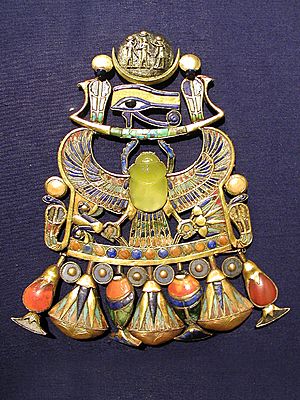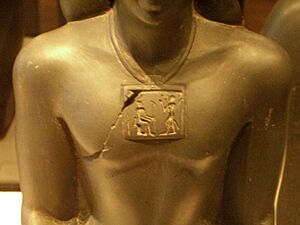Pectoral (Ancient Egypt) facts for kids

Pectorals were special pieces of jewelry worn in ancient Egypt. They often looked like a brooch or a large pendant. Many pectorals were also amulets, which people believed brought good luck or protection. Rich people and the pharaohs usually wore them.
One type of pectoral hung from a necklace around the neck, resting on the chest. Ancient statues from the Old Kingdom show people wearing pectorals this way.
Later pectorals were more like brooches. Their main purpose was to show important symbols and messages, rather than just being pretty jewelry. These messages often told stories about the pharaoh or about ancient Egyptian myths and culture. Pectorals were usually made of gold with colorful designs. These designs were created using a method called cloisonné, where tiny pieces of gemstones or colored glass were set into gold outlines.
Contents
What is a Pectoral?
In ancient Egypt, there were many words for "pectoral" or "collar." One word used a special sign called the Usekh collar determinative. This sign looked like a wide necklace. A determinative is a hieroglyph that helps you understand the meaning of a word.
The basic idea of a pectoral was a wide piece of jewelry. So, one Egyptian word for pectoral was usekh, which meant "breadth" or "to be wide." This is why the Usekh collar was also a wide necklace.
Different Kinds of Pectorals
Ancient Egyptian texts show that pectorals came in many forms. Some words for pectorals also meant bracelets or armlets. Others described necklaces with beads or metal breastplates.
Some pectorals were designed to hold amulets, like a serpent amulet. This shows that pectorals were not just decorative. They often included symbols that were important for protection or good fortune. Many of these words and their meanings come from old Egyptian writings, like those found on steles and papyri.
Pectorals in Ancient Statues
Ancient Egyptian statues often show people wearing different kinds of jewelry, including pectorals. Sometimes, it's hard to know exactly what the symbols on these pectorals mean. They might show offerings to gods or represent important ideas.
Famous Pectorals and Their Messages
Many famous pectorals had messages written in hieroglyphs. These messages were a big part of the pectoral's meaning, even more than its beauty.
One famous pectoral belonged to Amenemhat III. It has a message about his power as a ruler. The Pectoral of Amenemhat III says:
'Ny-Maat-Ra' was the throne name of Amenemhat III. The vulture goddess with her wings spread out on the pectoral represents "Lord of the Sky." This also suggests that the pharaoh himself was like the "Lord of the Sky."
"Pectorals as a Brooch" Gallery
-
This pectoral shows hieroglyphs like the ankh (life), a basket, the Eye of Horus, and the Sun Disk.
"Pectorals as Necklace" Gallery
-
This pectoral shows the Eye of Horus. It also has hieroglyphs like the Red crown, White crown, Shen ring, uraeus, and a mut vulture.
See also
- Gardiner's Sign List
- Gorget







